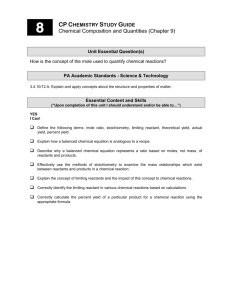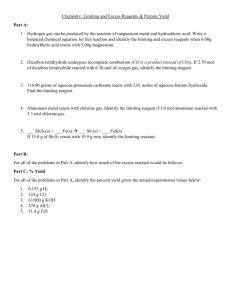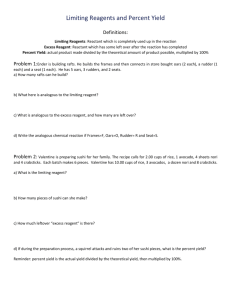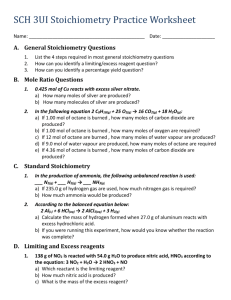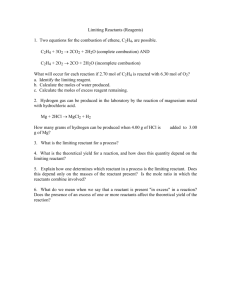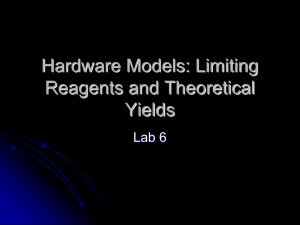LimitingReactants_Printable
advertisement
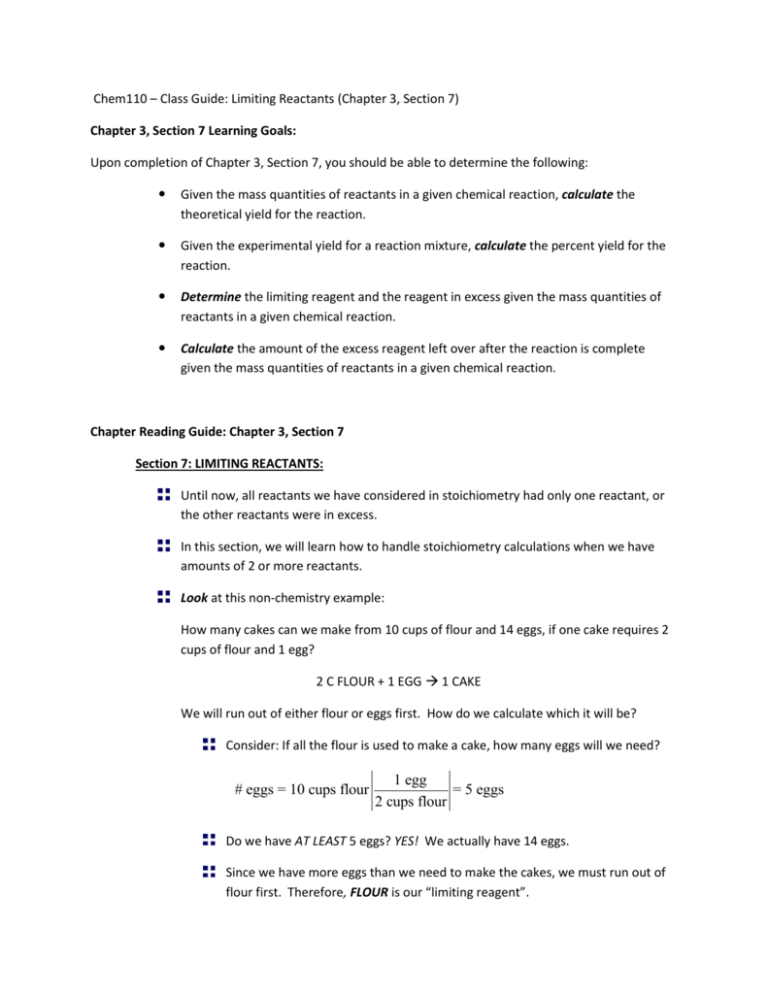
Chem110 – Class Guide: Limiting Reactants (Chapter 3, Section 7) Chapter 3, Section 7 Learning Goals: Upon completion of Chapter 3, Section 7, you should be able to determine the following: Given the mass quantities of reactants in a given chemical reaction, calculate the theoretical yield for the reaction. Given the experimental yield for a reaction mixture, calculate the percent yield for the reaction. Determine the limiting reagent and the reagent in excess given the mass quantities of reactants in a given chemical reaction. Calculate the amount of the excess reagent left over after the reaction is complete given the mass quantities of reactants in a given chemical reaction. Chapter Reading Guide: Chapter 3, Section 7 Section 7: LIMITING REACTANTS: Until now, all reactants we have considered in stoichiometry had only one reactant, or the other reactants were in excess. In this section, we will learn how to handle stoichiometry calculations when we have amounts of 2 or more reactants. Look at this non-chemistry example: How many cakes can we make from 10 cups of flour and 14 eggs, if one cake requires 2 cups of flour and 1 egg? 2 C FLOUR + 1 EGG 1 CAKE We will run out of either flour or eggs first. How do we calculate which it will be? Consider: If all the flour is used to make a cake, how many eggs will we need? # eggs = 10 cups flour 1 egg = 5 eggs 2 cups flour Do we have AT LEAST 5 eggs? YES! We actually have 14 eggs. Since we have more eggs than we need to make the cakes, we must run out of flour first. Therefore, FLOUR is our “limiting reagent”. How many eggs do we have left over? left over = amt started with – amt used So… left over = 14 eggs – 5 eggs = 9 eggs Now, how many cakes can we make? # cakes = 10 cups flour 1 cake = 5 cakes 2 cups flour Look at this chemistry example: Given the following reaction: 4 KO2 (s) + 2 H2O (l) 4 KOH (s) + 3 O2 (g) How many grams of O2 can be made from 14.0 g of KO2 and 18.0 g H2O? First, find the limiting reagent. If all the KO2 reacts, how much H2O will we need? g H2O =14.0 g KO2 1 mol KO2 2 mol H 2O 18.02 g H 2O = 1.77 g H 2O 71.1 g KO2 4 mol KO2 1 mol H 2O Referring to the reaction above, do we have AT LEAST 1.77 g of H2O? YES! We have more than that. Since we have more water than we need, we must run out of KO2 first. Therefore, KO2 is our limiting reagent – just like flour was in our non-chemistry example. TIP! Since KO2 is our limiting reagent, it will determine how much O2 we can make. SO…how much oxygen can we make? g O2 = 14.0 g KO2 1 mol KO2 3 mol O2 32.00 g O2 = 4.73 g O2 71.1 g KO2 4 mol KO2 1 mol O2 Now that we know how much oxygen we can make, let’s calculate how much water is left over – like we calculated how many eggs would be left over in the non-chemistry example. Left over = 18.0 g – 1.77 g = 16.2 g (Remember that the 1.77 g of H2O came from up above). Watch this movie: Limiting Reagents to help you understand limiting reagents (http://www.berks.psu.edu/clt/limitingreagent.mov) Review Sample Exercises 3.18 and 3.19 and try Practice Exercises 3.18 and 3.19. Practice working with equations using this interactive Limiting Reagents Learning Module. (http://www.bk.psu.edu/chem/module_LR.html) IMPORTANT TIPS! The smaller gram amount is not necessarily the limiting reagent, since the calculation goes through moles. DO THE MATH! Be sure to practice these…avoid getting stuck on these types of questions! THEORETICAL YIELDS After doing stoichiometry, there is an amount of product that can be formed, like the 4.73 grams of oxygen from the KO2 example. This amount is called the theoretical yield. In a lab, we never get that whole amount. We always get some amount less than the theoretical yield. This amount is called the actual yield. When reporting the yield obtained in a lab, we report a percent yield: actual yield percent yield = 100 theoretical yield Try Practice Exercise 3.20. Learning Resources Chapter Learning Goals Chapter 3, Section 7 Learning Goals Interactive Exercises Limiting Reagents Learning Module (http://www.bk.psu.edu/chem/module_LR.html) Additional Chapter Resources Movie: Limiting Reagents (http://www.berks.psu.edu/clt/limitingreagent.mov) Pre Class Assignment: This assignment must be completed prior to the next class. Check your syllabus for the exact due date and time. Complete the pre class assignment (http://berks.psu.edu/clt/chem110/Limiting_HW.doc) Submit a copy to the dropbox located in ANGEL called “Pre Class Assignment Submission: Limiting Reactants” End of Chapter Problems: Practice with these problems if you are having difficulty with any of the concepts covered in this class guide AFTER we have met in class. If you cannot easily complete these problems, seek help from your instructor, your mentor, or the learning center. Chapter 3: 73, 75, 77, 79, 81
